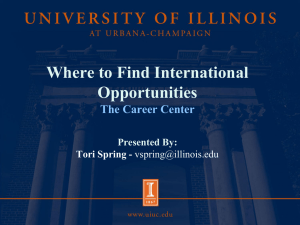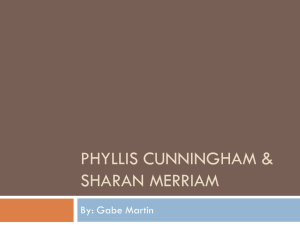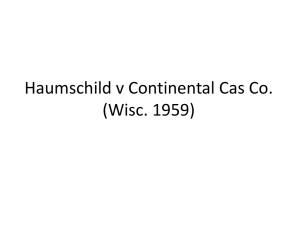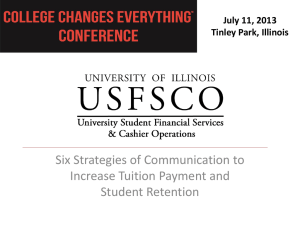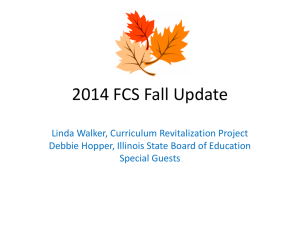Scholarly Support Services
advertisement
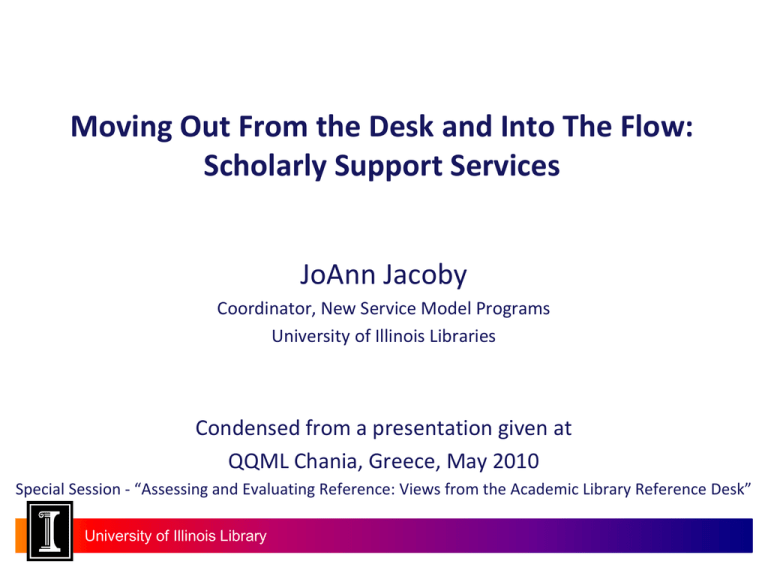
Moving Out From the Desk and Into The Flow: Scholarly Support Services JoAnn Jacoby Coordinator, New Service Model Programs University of Illinois Libraries Condensed from a presentation given at QQML Chania, Greece, May 2010 Special Session - “Assessing and Evaluating Reference: Views from the Academic Library Reference Desk” University of Illinois Library Outline of Presentation 1. Call to Action: From the Reference Desk to (embedded) Research Support 2. Scholarly Support Services at Illinois a. Why? Old metrics and needs assessment b. Examples of Scholarly Support Services c. What will success look like? University of Illinois Library Support for the Research Process: An Academic Library Manifesto Chris Bourg et al. for OCLC Research, November 2009 Call to Action In order to continue to play a central role in support of scholarly research and publishing, academic libraries must: • Embed library content, services, and staff within researchers’ regular workflows; integrating with services others provide…on campus, at other universities, or by commercial entities. • Embrace the role of expert information navigators and redefine reference as research consultation. University of Illinois Library Why New Service Modes at Illinois? University of Illinois Library Content is Common University of Illinois Library Biology Library reshelving stats, yearly total. University of Illinois Library University of Illinois Library Why New Service Modes at Illinois? University of Illinois Library New models for Research Support Services at Illinois Embedded (physically and/or virtually) in specific departments: • Biotechnology (and soon Biology & Life Sciences) • Labor and Employee Relations • Library and Information Science • Librarians Live at FLB (Foreign Language Building) • Multicultural/LGBT Broadly-focused service programs: • Scholarly Commons (data services, digitization, and scholarly communications, e-scholarship) • Savvy Researcher University of Illinois Library Labor and Employee Relations (LER): From Departmental Library to Embedded Librarian ILIR Library Closure (2007) Librarian located fulltime at BEL University of Illinois Library ILIR changed to LER Librarian located halftime at LER (2009) LER Service Profile Reference Collection management Library instruction Collaborative projects: • Research Publicity Committee • LER Leadership • P&T • Student forum • Website University of Illinois Library LER Reference Transactions University of Illinois Library Success Measures Projects Client organization Reference Library How do we measure success? Are the Library’s measures wellaligned with those of the client organization? Are we collocated or embedded? LIS New Service Model: Being Embedded • Designated office space and office hours GSLIS. • Attend faculty meetings. • On faculty listserv • Member of Curriculum Committee. • Attend lectures, roundtables, etc. • Guest lecture in classes (and occasionally teach credit courses.) • Socially embedded LIS Virtual Library: 15+ minutes 1-5 minutes LIS Embedded Interactions 11-15 minutes 6-10 minutes Faculty MS/CAS PhD Staff Other University of Illinois Library Biology and Life Sciences: Planning the Transition to a New Model Moving from a departmental library with 180,000 volumes and 4 full-time staff… to an embedded librarian collocated with computing and student support services University of Illinois Library Teaching/Instruction Sequence Submissions Plant Nomenclature Bibliographic searching Microarray analysis Database/Information Management GIS Imaging Bib Management Tools (Endnote/Refworks Bioinformatics Tools Genomic/Molecular database instruction Statistical Analysis NEW POSITION: Life Science Data Services Librarian •Some of the functions identified in the needs assessment (others through partnerships) •Digital repository services •Data curation University of Illinois Library Scholarly Commons Fall 2010 launch Why? The way research is happening is changing Interdisciplinary Enabled by technology Data intensive Collaborative Not only print based And we are getting involved earlier in the process Collaboration Content and service specialists Researchers (faculty and grad students) (Information) technology specialists and tools University Library Data Grant • Targeted acquisitions supporting research projects requiring numeric or spatial datasets • Competitive grants to faculty & grad students Usage/Downloads are not the most useful measure: • Only for deciding whether to continue licensing (did we find a larger audience?) Better measures of success: • Marketing (word of mouth, grants announcement) • Citations in thesis/publications (with credit!) • Relationships…Does this help position librarian as active partners in the research process? • Outcomes: facilitate research, forge relationships E-Science Group Information Profiles for faculty & research groups: http://hades.grainger.uiuc.edu/guy/pip.asp?icmt http://hades.grainger.uiuc.edu/guy/pip.asp?AMO • Google News results generated at page load • custom publication lists with links to full-text and citing articles • pre-stored search strategies • custom ES interface allowing on-the-fly searches scoped to a particular research domain Further reading: Ed Tallent. 2010.“Where are we going? Are we there yet?” Internet Reference Services Quarterly What will success look like for these new service models? • Use value -Customer-focused value proposition -Not just symbolic value/ego/nostalgia • Impact (not size!) -What difference do we make? • Relationships/partnerships (not tickmarks) -Library seen as essential partner in the research process University of Illinois Library New measures success From volume count Use value/usability • Supply content when, where and how the student/researcher needs it) • Digital repositories/data curation/scholarly communication From just in case Just in time (data grant) • May only get used by one person or research group, but used intensively University of Illinois Library New measures of success From gate countubiquitous library •IM/Text reference, librarians as active partners, mobile site, new book app, Libguides, course-integrated instruction From inputs & outputs outcomes & stories that demonstrate value • Harder to quantify, but quite tangible University of Illinois Library Thank you for your attention… With thanks to Sarah Shreeves, Sue Searing, Yoo-Seong Song and Scott Walter who contributed ideas or content included in this presentation University of Illinois Library


